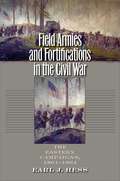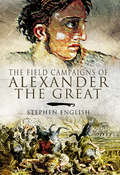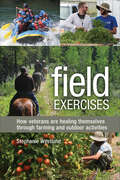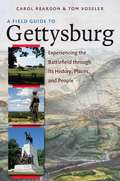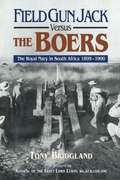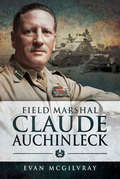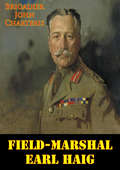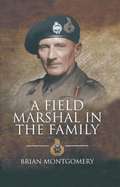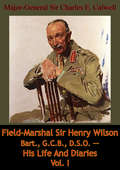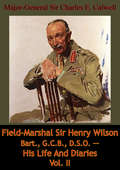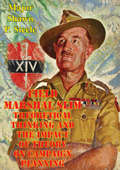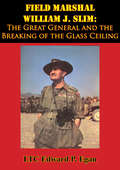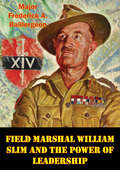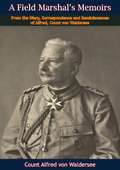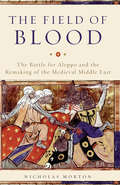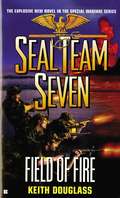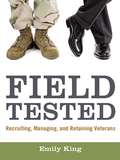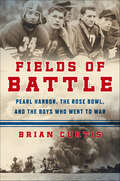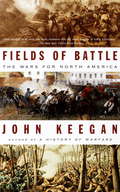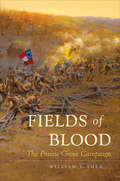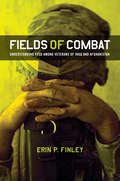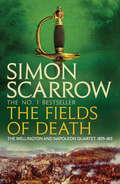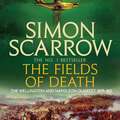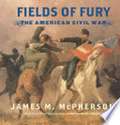- Table View
- List View
Field Armies and Fortifications in the Civil War
by Earl J. HessEarl J. Hess provides a narrative history of the use of fortifications--particularly trenches and other semi-permanent earthworks--used by Confederate and Union field armies at all major battle sites in the eastern theater of the Civil War. Hess moves beyond the technical aspects of construction to demonstrate the crucial role these earthworks played in the success or failure of field armies. A comprehensive study which draws on research and fieldwork from 300 battle sites, Field Armies and Fortifications in the Civil War is an indispensable reference for Civil War buffs and historians.
The Field Campaigns of Alexander the Great
by Stephen EnglishAlexander the Great is one of the most famous men in history, and many believe he was the greatest military genius of all time (Julius Caesar wept at the feet of his statue in envy of his achievements). Most of his thirteen year reign as king of Macedon was spent in hard campaigning which conquered half the then-known world, during which he never lost a battle. Besides the famous set-piece battles (Granicus, Issus, Gaugamela, Hydaspes), Alexander's army marched thousands of miles through hostile territory, fighting countless smaller actions and calling for a titanic logistical effort.There is a copious literature on Alexander the Great, but most are biographies of the man himself, with relatively few recent works analyzing his campaigns from a purely military angle. This book will combine a narrative of the course of each of Alexander's campaigns, with clear analysis of strategy, tactics, logistics etc. This will combine with Stephen English's The Army of Alexander the Great and The Sieges of Alexander the Great, to form a very strong three-volume examination of one of the most successful armies and greatest conquerors ever known.
Field Exercises: How Veterans Are Healing Themselves through Farming and Outdoor Activities
by Stephanie WestlundThere are nearly twenty-five million veterans and active-duty soldiers in North America. Some experts estimate that more than one quarter of these men and women suffer from post-traumatic distress, and many other military persons experience difficulty reintegrating into civilian life. While conventionally prescribed treatments primarily involve medication and therapy, many people are discovering additional ways to manage their injuries and reduce their suffering.Field Exercises: How Veterans Are Healing Themselves through Farming and Outdoor Activities shares the compelling stories of men and women who are finding relief from stressful and traumatic military experiences, while also establishing community networks and other peer support initiatives. Stephanie Westlund examines: The deep and far-reaching connections between nature and human health The tremendous impact of stress and trauma on survivors' lives Resources and groups providing opportunities in the emerging field of "Green Care".Field Exercises offers hope for veterans searching for methods to ease the transition to civilian life and recover from military stress and trauma. This book will appeal to millions of North American soldiers, veterans, and their loved ones, doctors, psychiatrists, social workers and other caregivers, other groups struggling with high rates of stress and post-traumatic experience, and all those interested in the relationship between nature and human health.Stephanie Westlund holds a PhD in peace and conflict studies. She has been conducting research with veterans since 2009, and continues to be inspired by their courage and personal resolve to move through pain toward recovery, and their unrelenting desire to serve their communities.
A Field Guide to Gettysburg
by Carol Reardon Tom VosslerIn this lively guide to the Gettysburg battlefield, Carol Reardon and Tom Vossler invite readers to participate in a tour of this hallowed ground. Ideal for carrying on trips through the park as well as for the armchair historian, this book includes comprehensive maps and deft descriptions of the action that situate visitors in time and place. Crisp narratives introduce key figures and events, and eye-opening vignettes help readers more fully comprehend the import of what happened and why. A wide variety of contemporary and postwar source materials offer colorful stories and present interesting interpretations that have shaped--or reshaped--our understanding of Gettysburg today.Each stop addresses the following: What happened here? Who fought here? Who commanded here? Who fell here? Who lived here? How did participants remember this event?
Field Gun Jack Versus the Boers: The Royal Navy in South Africa, 1899–1900
by Tony BridglandWar broke out in 1899 between the British and South African settlers of Dutch descent, the Boers, or Afrikaners as they are usually called today. Despite previous clashes, the British seriously underestimated their opponents. Although dressed in battered civilian clothes and made up entirely of volunteers, Boer troops were all mounted on horses and had very up-to-date German rifles.An even more unpleasant surprise than the mounted riflemen were the Boer artillery units. They were the only Boer troops to wear uniforms, were organized on a full-time basis, and were equipped with excellent German field pieces. The British artillery soon found itself out-gunned and out-ranged.Some British officers, however, were capable of adapting to the new conditions in South Africa. Royal Naval vessels anchored off the Cape had powerful, long-range cannons. It was decided to try bringing these guns ashore and mounting them on improvised carriages for field use. Naval infantry brigades had served in some previous campaigns, and proved capable of accompanying the army as gun crews, their straw hats and naval leggings identifiable in many wartime photographs.Although they were depicted in many wartime drawings and photographs, no serious study of the naval artillery has ever been done. Tony Bridgland has spent many years researching the topic and has produced a study of the technical problems involved in this unique operation, as well as a colourful narrative of naval personnel pressed into hazardous service far from the sea.
Field Marshal Claude Auchinleck
by Evan McGilvrayThis military biography explores the life and service of a British Indian Army officer who served with distinction across both world wars.During the First World War, Field Marshal Claude Auchinleck was awarded a Distinguished Service Order for his efforts in Egypt and the Mesopotamian Campaign. Afterward, he aided the pacification of the Northwest Frontier, now Pakistan. In the Second World War he briefly led a division in the ill-fated Norway campaign before being appointed Commander-in-Chief, India. Auchinleck is best remembered for his time as Commander-in-Chief of the Middle East Theatre, where he halted Rommel at the First Battle of El Alamein. He then resumed command in India, where his leadership was vital to success in Burma. In the post-war years, he planned and oversaw the Partition of India and the British withdrawal.In this extensively researched biography, historian Evan McGilvray examines Auchinleck’s long career as well as the transformations of the British military and the Empire itself.
Field-Marshal Earl Haig
by Colonel John Buchan Brigadier John CharterisIncludes 30 maps, plans and illustrations.A detailed personal account of Earl Haig, the man and his principle campaigns, by his closest colleague and confidante. The renowned novelist Buchan, who served under Chateris during the First World War, provides a foreword.“General Charteris had the privilege of serving with Lord Haig in India and at Aldershot, and for the whole of the Great War with the exception of the last two months. During the Battle of the Somme I had the privilege of serving under General Charteris. When, in 1921, the Official History was taking shape, Sir J. E. Edmonds asked Lord Haig whom he would like to go through it on his behalf, with special reference to the work of the I Corps, the answer was: “Send it to Charteris. He knows as much about it as I do.”This book is therefore a study of Lord Haig’s career by one who was himself a sharer in its most momentous stages. It is also a study of a famous soldier by one who brings to the task not only a knowledge of war, but the understanding born of a deep affection. A great man, especially a great man of action, is apt to appear before the world as a combination of abstract powers and virtues, impressive like a statue set up in some public place, but a little remote from our common life...Future historians will discuss every detail of his campaigns, and every aspect of his genius. But in the meantime the world has cause to be grateful, I think, to General Charteris for providing these mémoires pour servir —a personal narrative of how Lord Haig appeared to a colleague and a friend.”-Foreword.“The most competent and authoritative biography of Haig published to date, written by one who was closely associated with him. The book throws much light on Allied strategy as well as on the problem of the high command.”- William L. Langer – Foreign Affairs magazine
A Field Marshal in the Family
by Brian MontgomeryField Marshal Viscount Montgomery of Alamein has attracted the attention of countless historians over the last 70 years but, despite this coverage, views of his character remain controversial and contradictory. His younger brother Brian, himself a successful soldier, enters the fray with this charming and revealing book examining the background of this legendary military commander. He provides a fascinating account of the influences of Montys family genes together with a wealth of unknown details about his career. His grandfather, Sir Robert Montgomery, played a key role in crushing the Indian Mutiny and his adventures have intriguing parallels with those of Montys two generations later. Dean Farrar, his maternal grandfather, was a powerful Victorian educational and religious figure (Headmaster of Marlborough College and Dean of Canterbury) and author of the iconic Eric, or Little by Little.The author examines in the most entertaining and frank manner Montys idiosyncratic character traits; his opposition to tradition, his Nelsonian approach to rules and regulations, his ruthlessness and determination and his unfashionable views on the absolute necessity for self publicity and the most intensive training to get the maximum from his subordinates, down to the most junior levels.
Field-Marshal Sir Henry Wilson Bart., G.C.B., D.S.O. — His Life And Diaries Vol. I (Field-Marshal Sir Henry Wilson Bart., G.C.B., D.S.O. — His Life And Diaries #1)
by Marshal Ferdinand Foch Major-General Sir Charles E. Calwellthe First World War, who was a passionate "Westerner" and advocate of the Anglo-French alliance. Major-General C. E. Callwell recounts the story of the outspoken, opinionated and well connected Field Marshal using extensive quotes from his diary, often dripping with acerbic wit, in the greatest of detail."Field Marshal Sir Henry Wilson, an Irishman who in June 1922 was assassinated on his doorstep in London by Irish republicans, was one of the most controversial British soldiers of that age. Before 1914 he did much to secure the Anglo-French alliance and was responsible for the planning which saw the British Expeditionary Force successfully despatched to France after the outbreak of war with Germany. A passionate Irish unionist, he gained a reputation as an intensely 'political' soldier, especially during the 'Curragh crisis' of 1914 when some officers resigned their commissions rather than coerce Ulster unionists into a Home Rule Ireland. During the war he played a major role in Anglo-French liaison, and ended up as Chief of the Imperial General Staff, professional head of the army, a post he held until February 1922. After Wilson retired from the army, he became an MP and was chief security adviser to the new Northern Ireland government. As such, he became a target for nationalist Irish militants, being identified with the security policies of the Belfast regime, though wrongly with Protestant sectarian attacks on Catholics. He is remembered today in unionist Northern Ireland as a kind of founding martyr for the state. Wilson's reputation was ruined in 1927 with the publication of an official biography, which quoted extensively and injudiciously from his entertaining, indiscreet, and wildly opinionated diaries, giving the impression that he was some sort of Machiavellian monster."-Professor Keith Jeffrey.
Field-Marshal Sir Henry Wilson Bart., G.C.B., D.S.O. — His Life And Diaries Vol. II (Field-Marshal Sir Henry Wilson Bart., G.C.B., D.S.O. — His Life And Diaries #2)
by Marshal Ferdinand Foch Major-General Sir Charles E. CalwellThese two volumes form the official biography of Sir Henry Wilson, a key figure in the British Army during the First World War, who was a passionate "Westerner" and advocate of the Anglo-French alliance. Major-General C. E. Callwell recounts the story of the outspoken, opinionated and well connected Field Marshal using extensive quotes from his diary, often dripping with acerbic wit, in the greatest of detail."Field Marshal Sir Henry Wilson, an Irishman who in June 1922 was assassinated on his doorstep in London by Irish republicans, was one of the most controversial British soldiers of that age. Before 1914 he did much to secure the Anglo-French alliance and was responsible for the planning which saw the British Expeditionary Force successfully despatched to France after the outbreak of war with Germany. A passionate Irish unionist, he gained a reputation as an intensely 'political' soldier, especially during the 'Curragh crisis' of 1914 when some officers resigned their commissions rather than coerce Ulster unionists into a Home Rule Ireland. During the war he played a major role in Anglo-French liaison, and ended up as Chief of the Imperial General Staff, professional head of the army, a post he held until February 1922. After Wilson retired from the army, he became an MP and was chief security adviser to the new Northern Ireland government. As such, he became a target for nationalist Irish militants, being identified with the security policies of the Belfast regime, though wrongly with Protestant sectarian attacks on Catholics. He is remembered today in unionist Northern Ireland as a kind of founding martyr for the state. Wilson's reputation was ruined in 1927 with the publication of an official biography, which quoted extensively and injudiciously from his entertaining, indiscreet, and wildly opinionated diaries, giving the impression that he was some sort of Machiavellian monster."-Professor Keith Jeffrey.
Field Marshal Slim - Theoretical Thinking And The Impact Of Theory On Campaign Planning
by Major Shawn P. SteeleField Marshall Viscount Slim holds a special place in modern military history. He soundly defeated the Imperial Japanese Army in Burma in 1945, retaking the strategically important Burma Road, and safeguarding the Chinese Theater from sure culmination. By all accounts, Slim is a military genius, having achieved this notable victory even after the Japanese 15th Army pushed Allied troops all the way back to India. The historical records attribute Slim's success to his superior ability to lead soldiers in combat, but they tell only half the story. By tracing Slim's implicit process of theoretical thinking, using an observe, interpret, hypothesize, test, and prescribe action framework, this story demonstrates that Slim's genius came from a combination of his abilities to lead and think theoretically. Specifically, in the case of Slim, his ability to think theoretically afforded him the opportunity to develop a new operational approach-a paradigm shift of sorts-and his leadership made it possible to motivate his men to employ that approach. The author asserts that it is the presence of these two abilities in a single man that make him a superior military commander.
Field Marshal William J. Slim: The Great General and the Breaking of the Glass Ceiling
by LTC Edward P. EganField Marshal William J. Slim is considered by many historians to be one of the finest generals of World War II. His accomplishments were truly extraordinary. He commanded a polyglot army, consisting of six different nationalities speaking eight different languages, that fought in some of the most inhospitable, disease-ridden country in the world against the war's toughest opponent, the Japanese. In March 1942, he assumed command of a British-Indian force in Burma half way through the longest retreat in the British Army's history. Even though he was unable to reverse the disaster, he kept his force intact and led it to safety. Over the next three and one half years, despite very limited resources and several inept senior commanders, he rebuilt his force into an army that was able to inflict on the Japanese their greatest land defeat of World War II. In the process, he conducted four of the most classic operational campaigns of the war--the battle of the Second Arakan; the battles of Kohima and Imphal; the capture of Mandalay and Meiktila; and the pursuit to Rangoon. Throughout his career, but especially during World War II, Slim met all the criteria for a great general and strategic leader as set forth in Lord Wavell's Generals and Generalship. Despite these great accomplishments, Slim ran into several "glass ceilings" during World War II. Twice he was relieved of command, once immediately after his greatest battlefield victory. This study examines Field Marshal Slim's leadership. It takes a brief look at his biography, then compares him against Wavell's standards for generalship by highlighting events from his career that illustrate each standard. Finally, it addresses the issue of the "glass ceiling"--what it is, the events surrounding Slim's encounters with it, and how Slim was able to overcome it. The intent is to show that Slim was not only a great World War II general, but is still a model of leadership worthy of study by the U.S. Army.
Field Marshal William Slim And The Power Of Leadership
by Major Frederick A. BaillergeonOn 15 January 1942 the Japanese invaded Burma. Within months, the Japanese occupied the country and forced the Allied forces to conduct a brutal retreat into neighboring India. During the next three and one half years, both forces continued to fight in a campaign with the Allied forces retaking Burma in May 1945. One of the principle figures in this turnaround of the Allied Force was Field Marshal William Slim. During the Burma Campaign Slim served in several key leadership positions culminating as the 14 Army Commander. This focus of this study is to determine the role Slim played in the reconquest of Burma. Specifically, how did Field Marshal William Slim's organizational leadership actions (as defined in the U.S. Army leadership manual, FM 22-100) while serving as the 14 Army Commander, contribute to the Allies reconquest of Burma during World War II? It is hoped that the findings of this study will be of value to leaders of all levels currently fighting the Global War on Terrorism.
A Field Marshal’s Memoirs: From the Diary, Correspondence and Reminiscences of Alfred, Count von Waldersee
by Count Alfred von WalderseeThe present volume is the 1924 English translation of Field-Marshal Alfred Count von Waldersee’s memoirs by Frederic Whyte.“Field-Marshal Alfred Count von Waldersee’s Denkwürdigkeiten are in three volumes in the German edition. The two first, covering the years 1832-1900, were issued at the end of 1922; the third, covering the period August 1900-March 1904, appeared late in 1923. The entire work was edited by Herr Heinrich Otto Meisner, with the approval and assistance of the Field-Marshal’s nephew, Lieut.-General George Count von Waldersee, who contributed a brief Preface to Volume I. The nephew acclaims the uncle as ‘Christian, Nobleman, Prussian, German, Soldier and Servant of his Sovereigns.”“There is a second Preface by Herr Meisner, who abstains from panegyrics and merely explains how the work has been pieced together. The Field-Marshal, it seems, had intended eventually to prepare a book of Reminiscences for the press, but only a very few pages of the Denkwürdigkeiten as printed were written with a view to publication. They have been compiled almost altogether from private diaries, correspondence and memoranda. Hence the impression which they give of absolute genuineness; hence, also, much of their value as a trustworthy historical document. As the well-known critic, Richard Bahr, remarked in the Münchener Zeitung, the work presents in this respect a welcome contrast with many of the autobiographical volumes which have recently appeared in Germany—’self-justification-screeds,’ as he calls them. The Reminiscences which the Field-Marshal contemplated writing might, indeed, have had to be placed in the same category, but here we have the author almost ‘un-retouched,’ and almost as natural and as ingenuous as Pepys.”—Frederic Whyte
The Field of Blood: The Battle for Aleppo and the Remaking of the Medieval Middle East
by Nicholas MortonA history of the 1119 Battle of the Field of Blood, which decisively halted the momentum gained during the First Crusade and decided the fate of the Crusader states In 1119, the people of the Near East came together in an epic clash of horses, swords, sand, and blood that would decide the fate of the city of the Aleppo--and the eastern Crusader states. Fought between tribal Turkish warriors on steppe ponies, Arab foot soldiers, Armenian bowmen, and European knights, the battlefield was the amphitheater into which the people of the Near East poured their full gladiatorial might. Carrying a piece of the true cross before them, the Frankish army advanced, anticipating a victory that would secure their dominance over the entire region. But the famed Frankish cavalry charge failed them, and the well-arranged battlefield dissolved into a melee. Surrounded by enemy forces, the crusaders suffered a colossal defeat. With their advance in Northern Syria stalled, the momentum of the crusader conquest began to evaporate, and would never be recovered.
Field of Fire (Seal Team Seven #19)
by Keith DouglassLieutenant Commander Blake Murdock and five members of Seal Team Seven are assigned to back up the CIA on a covert operation in Syria. Their mission: destroy the laboratory housing an electromagnetic pulse (EMP) bomb capable of rendering all electronic components within a hundred-mile radius inoperative. But just when the SEALs think they've been successful, an EMP is detonated just off the coast of Haifa, Israel, disabling the entire city. As Israel's military defends its land from Syrian invasion, Seal Team Seven must enter the fray - and rescue ten American college students trapped in the chaos.
Field Tested: Recruiting, Managing, and Retaining Veterans
by Emily KingVeterans are a tremendous source of untapped talent and come with a wealth of skills and experience beyond those of typical civilian employees. Field Tested gives readers the insight and tools they need to recruit and retain veterans, and to maximize their value in any organization. A must-read for leaders, managers, and human resources professionals across industries, Field Tested uncovers key cultural differences between the military and civilian workplace, and reveals how these differences can affect employee performance, satisfaction, and retention. Complete with real-world examples, practical models, and savvy advice, this book shows readers how to: ò Attract and interview veterans ò On-board them quickly and effectively ò Position them for success ò Ensure a smooth cultural transition ò Manage performance ò Help them develop lasting careers. Smart companies that hire veterans owe it to themselves and their employees to under stand the unique considerations involved. This one-of-a-kind guide reveals how to make the most of AmericaÆs top talent.
Fields of Battle: Pearl Harbor, the Rose Bowl, and the Boys Who Went to War
by Brian CurtisA riveting and emotional tale of the boys who played in the 1942 Rose Bowl and then served on the WWII battlefields—a story of football, wartime, and boys becoming men.In the wake of the bombing of Pearl Harbor, the 1942 Rose Bowl was moved from Pasadena to Durham, North Carolina, out of fear of Japanese attacks on the West Coast. It remains the only Rose Bowl game to ever be played outside of Pasadena. Duke University, led by legendary coach Wallace Wade Sr., faced off against underdog Oregon State College, with both teams preparing for a grueling fight on the football field while their thoughts wandered to the battlefields they would soon be on. As the players and coaches prepared for the game, America was preparing for war. President Franklin D. Roosevelt and British Prime Minister Winston Churchill met to discuss the Allied strategy in Europe; a discussion that would change the lives of the boys and men on the field in Durham.Finally, on New Year’s Day 1942, under dark gray skies and occasional rain, the two teams clashed on the gridiron in front of a crowd of 56,000, playing one of the most unforgettable games in history. Shortly afterward, many of the players and coaches entered the military and would quickly become brothers on the battlefield. Scattered around the globe, the lives of Rose Bowl participants would intersect in surprising ways, as they served in Iwo Jima and Normandy, Guadalcanal and the Battle of the Bulge. Four players from that Rose Bowl game would lose their lives, while many more were severely wounded. In one powerful encounter on the battlefield, OSC’s Frank Parker saved the life of Duke’s Charles Haynes as he lay dying on a hill in Italy. And one OSC player, Jack Yoshihara, a Japanese-American, never had the chance to play in the game or serve his country, as he was sent to an internment camp in Idaho. In this riveting an emotional tale, Brian Curtis sheds light on a little-known slice of American history and captures in gripping detail an intimate account of the teamwork, grit, and determination that took place on both the football fields and the battlefields of World War II. It was a game created by infamy and a war fought by ordinary boys who did the extraordinary.
Fields of Battle
by John KeeganAt once a grand tour of the battlefields of North America and an unabashedly personal tribute to the military prowess of an essentially unwarlike people, Fields of Battle spans more than two centuries and the expanse of a continent to show how the immense spaces of North America shaped the wars that were fought on its soil. of photos.
Fields Of Blood
by William L. SheaWilliam Shea offers a gripping narrative of the events surrounding Prairie Grove, Arkansas, one of the great unsung battles of the Civil War that effectively ended Confederate offensive operations west of the Mississippi River. Shea provides a colorful account of a grueling campaign that lasted five months and covered hundreds of miles of rugged Ozark terrain. In a fascinating analysis of the personal, geographical, and strategic elements that led to the fateful clash in northwest Arkansas, he describes a campaign notable for rapid marching, bold movements, hard fighting, and the most remarkable raid of the Civil War.
Fields of Combat: Understanding PTSD among Veterans of Iraq and Afghanistan (The Culture and Politics of Health Care Work)
by Erin P. Finley"If you consider Iraq—like I do, probably twenty-nine out of thirty days—to be the pinnacle of your life, then where do you go from there? And I'm sure that a lot of veterans feel that way. To them, that was it. That was everything. So now what? They have to find something meaningful and purposeful.""When I got back from Afghanistan, there was not even so much as a briefing that said, 'Let us know if you're having problems.' There wasn't so much as a phone number. There was literally nothing.""I knew it was crazy. I was thinking, the guy on the roof's either a sniper or he's going to radio ahead. And then I thought, this is San Antonio. There's not snipers on the roof, nobody's going to blow me up here.""Whenever I look at people back here at home, I know what they're going to look like dead. I know what they look like with their brains blown out or jaws blown off or eyes pulled out. When I look at somebody I see that, to this day."—Voices of veterans interviewed in Fields of CombatFor many of the 1.6 million U.S. service members who have served in Iraq and Afghanistan since 2001, the trip home is only the beginning of a longer journey. Many undergo an awkward period of readjustment to civilian life after long deployments. Some veterans may find themselves drinking too much, unable to sleep or waking from unspeakable dreams, lashing out at friends and loved ones. Over time, some will struggle so profoundly that they eventually are diagnosed with post-traumatic stress Disorder (PTSD).Both heartbreaking and hopeful, Fields of Combat tells the story of how American veterans and their families navigate the return home. Following a group of veterans and their personal stories of war, trauma, and recovery, Erin P. Finley illustrates the devastating impact PTSD can have on veterans and their families. Finley sensitively explores issues of substance abuse, failed relationships, domestic violence, and even suicide and also challenges popular ideas of PTSD as incurable and permanently debilitating. Drawing on rich, often searing ethnographic material, Finley examines the cultural, political, and historical influences that shape individual experiences of PTSD and how its sufferers are perceived by the military, medical personnel, and society at large. Despite widespread media coverage and public controversy over the military's response to wounded and traumatized service members, debate continues over how best to provide treatment and compensation for service-related disabilities. Meanwhile, new and highly effective treatments are revolutionizing how the Department of Veterans Affairs (VA) provides trauma care, redefining the way PTSD itself is understood in the process. Carefully and compassionately untangling each of these conflicts, Fields of Combat reveals the very real implications they have for veterans living with PTSD and offers recommendations to improve how we care for this vulnerable but resilient population.
The Fields of Death (The Wellington and Napoleon Quartet)
by Simon ScarrowTHE FIELDS OF DEATH is the epic final novel in Simon Scarrow's bestselling Wellington and Napoleon Quartet. Essential reading for fans of Bernard Cornwell.1809. Viscount Wellington and Emperor Napoleon Bonaparte have made their mark as military commanders. Lifelong enemies, they both believe their armies are strong enough to destroy any rival. But in war victory can never be certain.While Wellington's success continues in Spain, Napoleon feels the sting of failure. Yet despite a disastrous Russian campaign and humiliating defeat at Leipzig, he persists in fighting on.With Napoleon's power waning, the newly titled Duke of Wellington is perfectly placed to crush the tyrant. But his enemy refuses to surrender, and so the two giants must face a final reckoning on the bloody battlefield of Waterloo...
The Fields of Death: (Revolution 4) (The Wellington and Napoleon Quartet)
by Simon ScarrowTHE FIELDS OF DEATH is the epic final novel in Simon Scarrow's bestselling Wellington and Napoleon Quartet. Essential reading for fans of Bernard Cornwell.1809. Viscount Wellington and Emperor Napoleon Bonaparte have made their mark as military commanders. Lifelong enemies, they both believe their armies are strong enough to destroy any rival. But in war victory can never be certain.While Wellington's success continues in Spain, Napoleon feels the sting of failure. Yet despite a disastrous Russian campaign and humiliating defeat at Leipzig, he persists in fighting on.With Napoleon's power waning, the newly titled Duke of Wellington is perfectly placed to crush the tyrant. But his enemy refuses to surrender, and so the two giants must face a final reckoning on the bloody battlefield of Waterloo...(P)2017 Headline Digital
Fields of Fire
by Terry CoppWith Fields of Fire, Terry Copp challenges the conventional view that the Canadian contribution to the Battle of Normandy was a "failure" - that the allies won only through the use of brute force, and that the Canadian soldiers and commanding officers were essentially incompetent. His detailed and impeccably researched analysis of what actually happened on the battlefield portrays a flexible, innovative army that made a major, and successful, contribution to the defeat of the German forces in just seventy-six days.Challenging both existing interpretations of the campaign and current approaches to military history, Copp examines the Battle of Normandy, tracking the soldiers over the battlefield terrain and providing an account of each operation carried out by the Canadian army. In so doing, he illustrates the valour, skill, and commitment of the Allied citizen-soldier in the face of a well-entrenched and well-equipped enemy army.This new edition of Copp's best-selling, award-winning history includes a new introduction that examines the strategic background of the Battle of Normandy.
Fields Of Fury: The American Civil War
by James M. McPhersonPulitzer Prize award-winning historian James M. McPherson has written for young readers a stirring account of the greatest conflict to happen on our nation's soil, the Civil War, bringing to life the tragic struggle that divided not only a nation, but also friends and family. <p><p> From the initial Confederate attack on Fort Sumter, to the devastating loss of life at Shiloh as Ulysses S. Grant led the Union to unexpected victory, to the brilliance of Stonewall Jackson's campaign at Shenandoah, to General Pickett's famous charge at Gettysburg, to the Union's triumph at Appo-mattox Court House, Fields of Fury details the war that helped shape us as a nation. Also included are personal anecdotes from the soldiers at the battlefront and the civilians at home, as well as profiles of historical luminaries such as Robert E. Lee, Abraham Lincoln, Jefferson Davis, and Ulysses S. Grant. McPherson also explores the varied roles that women played during the war, healthcare on the battlefield, and the demise of slavery. McPherson's narrative is highlighted with black-and-white photographs taken by Civil War photographers Mathew Brady and Timothy O'Sullivan, period oil paintings, and key campaign and battlefield maps, that make Fields of Fury the consummate book on the American Civil War for kids.
